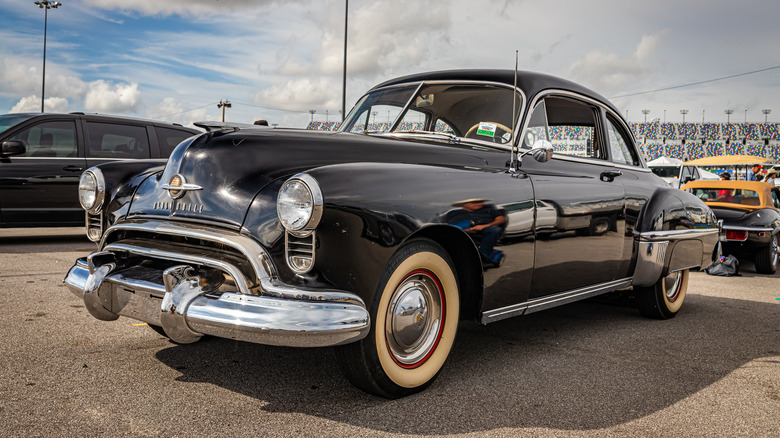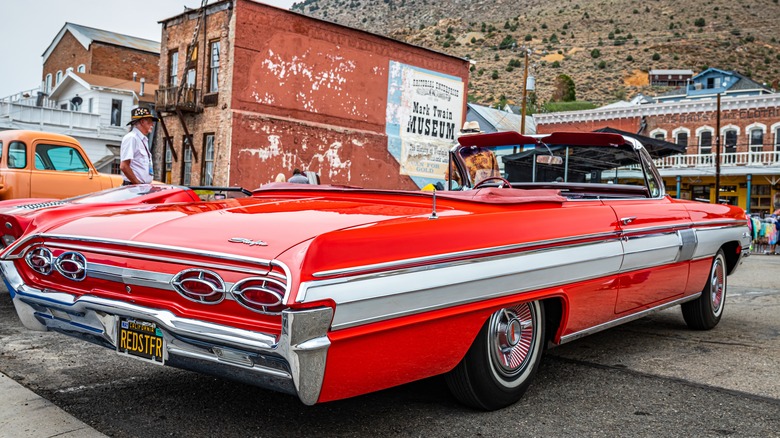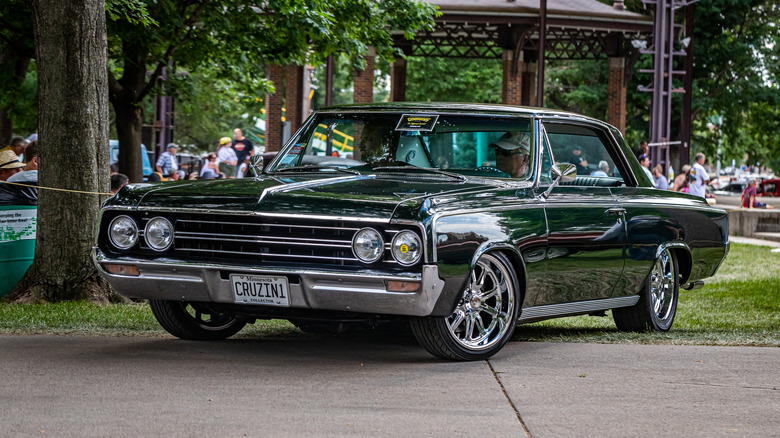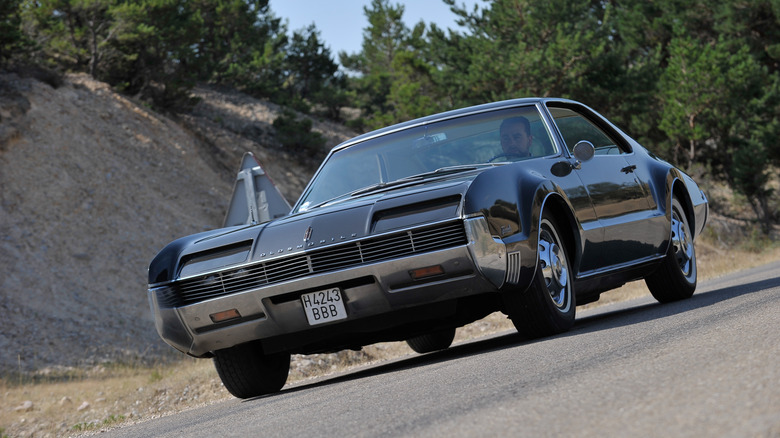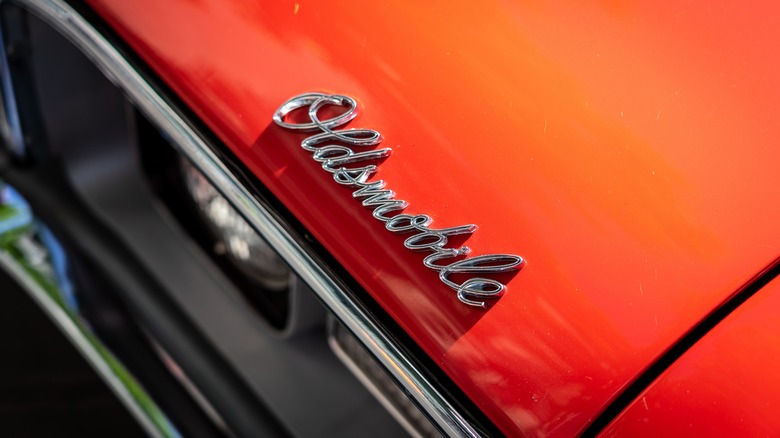
Sergey Kohl/Shutterstock
Until it was shut down in 2004, Oldsmobile had a long history of innovation with its automobiles. That’s why it’s not a big surprise it may have been the first to build a muscle car. Though it was over a decade before the period most people understand as the muscle car era (early ’60s to early ’70s), Oldsmobile holds that distinction with the release of the Rocket 88 in 1949. Though it didn’t have the look of later muscle cars, it had the main two ingredients you need: a lighter body than a full-size car and a huge engine.
Oldsmobile went on to be one of the favorite car companies of the muscle car era, with several models that are sought after by car collectors to this day. It was the first car company to use an assembly line (often falsely attributed to Henry Ford), made a front-wheel-drive muscle car (the only one from that time), and was constantly heralded as a division of GM that would take chances on cars to make the rest of their offerings better.
With that in mind, check out a few of the classic Oldsmobile models that deserve your attention.
1949 Oldsmobile Super Rocket 88
Gestalt Imagery/Shutterstock
Many people say Oldsmobile’s Rocket 88 was the first American muscle car. Obviously, as a car from the late ’40s, it didn’t have the same style as the “muscle car era” cars we’re accustomed to, but it did have the main two factors down pat: it was lighter weight than full-sized cars, and it had a formidable engine under the hood. It’s important to point out early that the official name for the car was the Super 88, but the engine’s name is the Rocket 88, and most gearheads use that as shorthand for the car’s name. For that reason, we will too.
The Rocket 88 featured an aerodynamic design and a 160hp 303ci V8 engine capable of up to 265-foot pounds of torque. With that kind of engine, it would make it easy to accelerate onto the newly laid interstates spreading across the nation and maintain a healthy speed with the power to comfortably traverse the country. Amazingly, the Rocket 88 engine has since been termed a classic that would continue to outclass many cars released during the ’50s.
Perhaps the most important factor that made it the starting point for muscle cars as we know them today was that high horsepower engines and performance cars were no longer just for the wealthy; the Rocket 88 was largely affordable enough for anyone who wanted one.
1961 Oldsmobile Starfire
Gestalt Imagery/Shutterstock
The 1961 Oldsmobile Starfire was unique to most muscle cars of the era by being offered as a convertible only. But what a convertible it was! Imagine driving down a beach-front highway in the summer with the top down; this car had smooth lines and a profile that would turn heads immediately. Don’t forget that this car was aimed at top-tier cars from other brands like the Ford Thunderbird, so it had all the amenities. It had air conditioning, power steering, power brakes, and a radio, so you had background music while you cruised the coastline. It even had a power seating adjustment for the driver, which was way ahead of its time.
What’s crazy about the Oldsmobile Starfire is just how luxurious it was for the time. When you think of the top-of-the-line GM sportscar, you’d probably pick out the Corvette, and you’d be right. But to put it in perspective, the latest Corvette for that year would cost you a little more than $3,400. The ’61 Starfire went for $4,600. Only 1,500 Starfires were ever made, so you know they’re highly sought after today, and from our standpoint, that makes perfect sense.
1964 Oldsmobile Cutlass 442
Different_brian/Getty Images
When Pontiac saw success with the GTO in early 1964, Oldsmobile knew it had to have a car to match all that power. Enter the 1964 Oldsmobile Cutlass 442 by the end of the year. The history behind the name was that the car had a four-barrel carburetor, a four-speed transmission, and dual exhaust. While Pontiac had great success selling the GTO to younger people who wanted more power, the 442 wasn’t marketed as well by Oldsmobile, getting the 442 off to a bad start. Later, the 442 would go on to be recognized as one of the company’s most cherished muscle cars.
Part of the allure of the 442 was it offered a straight-to-the-point body design. Its straight lines from front to back gave off a no-nonsense vibe, and the engine largely did the same. It came loaded with a 330 CID V8 engine, an upgraded air cleaner, and a high-quality rod that pumped it up to 310 horsepower. But it wasn’t just engine performance that would get raves for this car from drivers; it also had a heavy-duty suspension that included anti-roll bars at the front and rear, giving drivers a much smoother ride than many of the high-powered cars of that time.
1966 Oldsmobile Toronado
FernandoV/Shutterstock
The 1966 Oldsmobile Toronado was a departure from the classic straight lines of the Cutlass 442, adding a curvier model to entice buyers looking for a stylish muscle car. Aside from the styling details, the first and most notable thing about the Toronado is that it had a front-wheel drive. Front-wheel drives were not common in that era, and when you add the 385 hp 455 V8 engine to power it, it makes for enormous acceleration and an incredibly smooth driving experience. It also offered the turbo-hydramatic heavy-duty three-speed automatic transmission, but there was no option for a manual transmission on the Toronado.
One important thing to remember about the Toronado is that it was aimed at drivers who wanted a little more luxury than base models. Oldsmobile was trying to go up against cars like the Buick Riviera and the Ford Thunderbird. As a result, it came with air conditioning, power steering, and power brakes. The only downside to the Toronado in that initial offering was it came with drum brakes on all four wheels. The problem was the car weighed a whopping 4,500 pounds, and those brakes would suffer every time you had to slow down or come to a stop. This is probably why, in the following year, Oldsmobile’s 1967 Toronado came upgraded with disc brakes to give them longer-lasting stopping ability.
1968 Hurst Oldsmobile
Oldsmobile, throughout the early years of the muscle car era (despite some powerful entries), suffered from an image problem. The issue was it had a tough time gaining popularity with America’s young people and general “hot rod” culture. Oldsmobile wanted to change that, and to make it happen; it employed George Hurst of Hurst Shifter fame to make a car that used one of Plymouth’s higher-powered engines to date with the 455 cubic-inch Rocket V8.
It’s important to understand that the 1968 Hurst Oldsmobile was built off the body of the third-generation 442, but It didn’t have the straight-lined design of the original ’64 442. It had been updated with a new body type shared with the Oldsmobile Cutlass of that year. Even with the body upgrade, the Hurst Olds delivered on what would become the ideal look for a muscle car with its wider body and low overall profile that implied “this car is fast.” It didn’t lie.
As a sort of specialty third-party vehicle, the ’68 Hurst Olds was in a class all its own, but looking back, it was one of the signature muscle cars of the era.
[Image by SsmIntrigue via Wikimedia Commons | Cropped and scaled | CC BY-SA 4.0]
1970 Oldsmobile Rallye 350
You can’t talk about Oldsmobile muscle cars without mentioning the 1970 Oldsmobile Rallye 350. These mean-looking machines turned heads immediately, but once you realized how smoothly they ran, they became one of the great muscle cars of that era. Everything from the suspension, transmission, and gears could be swapped out for a customizable driving experience. Unfortunately, the one thing you might have wanted to customize had no other options. It turns out that part of the reason these cars turned heads was because every single one was manufactured in fluorescent “Sebring” yellow.
While the bright yellow color alone may have been enough to turn off some buyers, the Rallye 350 also didn’t come with chrome features and highlights that were very popular at the time. It was even claimed that some dealerships were known to replace the bumpers and wheels with chrome versions just to get more of them out the door.
The 1970 Oldsmobile Rallye 350 was only sold for one year, and only 3,547 were built. Even though they were good quality cars, they didn’t sell as well as expected, but their limited supply is part of what makes them so fervently sought after today.
[Image by Greg Gjerdingen via Wikimedia Commons | Cropped and scaled | CC BY-SA 4.0]
>>> Read full article>>>
Copyright for syndicated content belongs to the linked Source : SlashGear – https://www.slashgear.com/1463112/old-school-oldsmobile-cars-worth-attention/




















